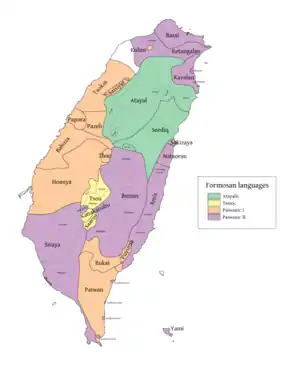排灣語群
排灣語群(Paiwanic)為台灣原住民使用的南島語系之一,為 Blust(1977)提出的分類方式,現時已多不採用。[1][2][3] 此種分類法將分布在台灣北中南、西部及東部高山與平地等地區的語言都涵蓋在內,[4][5]而依據費羅禮(1969)之研究,此分類下又可再分為排灣群I及排灣語群II。[6]
| 排灣語群 | |
|---|---|
| Paiwanic languages | |
| 已廢除 | |
| 地理分佈: | 台灣 |
| 谱系学分类: | 南島語系
|
| 分支: |
排灣語群I
排灣語群II
|
| – | |
 排灣語群I
排灣語群II | |
語群分佈
依據費羅禮(1969)之研究,此分類下又可再分為排灣語群I及排灣語群II。[6]
排灣群I
排灣群I分有14個語種,雷朗語、龜崙語、賽夏語、道卡斯語、巴宰語、噶哈巫語、邵語、巴布拉語、巴布薩語、虎尾壟語、洪雅語、排灣語、卑南語、魯凱語等語種。其中、排灣語、卑南語、魯凱語、以及賽夏語歸屬為高山族語,其餘歸屬平埔族語。
排灣群II
排灣群II包含現時分類下的東台灣南島語族以及布農語,這個語群共同的音變是古南島語*C、*t的合併。然而,李壬癸(2006)認為,*C、*t的合併也發生在馬玻語族,是常見的音變,不足以做為分群依據。李壬癸(2006)將布農語歸入南台灣南島語族,而將東台灣南島語族獨立,分有8個語種,巴賽語、噶瑪蘭語、猴猴語、撒奇萊雅語、阿美語(邦查語)、西拉雅語、大滿語、馬卡道語等語種。其中,阿美語與撒奇萊雅語歸屬於高山族語,其餘歸屬平埔族語。不過李壬癸院士研究認為阿美語及撒奇萊雅語傾向歸屬於平埔族語而非高山族語。一來、阿美族與撒奇萊雅族是居住於平地而非高山,二則高山族與平埔族之別可以從是否有向清朝及日本政府繳稅來區分,[4]並非以語言差異做為區別。
此語族可再細分為「北部語群」、「中部語群」,以及「西南部語群」:
參見
- 台灣語言列表
- 台灣南島語言
註釋
- Darrell Tyron. (1995) Proto-Austronesian and the Major Austronesian Subgroups. In The Austronesians: Historical and Comparative Perspectives. Edited by Peter Bellwood, James J. Fox, and Darrell Tyron. Canberra: Department of Anthropology, Research School of Pacific and Asian Studies, Australian National University, 1995. viii, 359 pp.
- Blust, Robert (1999). Subgrouping, circularity and extinction: some issues in Austronesian comparative linguistics. In Selected Papars from The Eighth International Conference on Austronesian Linguistics The Eighth International Conference on Austronesian Linguistics.
- Ethnologue data from Ethnologue: Languages of the World - ,引用於2019年07月18日
- Li, Paul Jen-kuei. 2004. "Origins of the East Formosans: Basay, Kavalan, Amis, and Siraya" (PDF). [2014-02-02]. (原始内容 (PDF)存档于2009-03-27).. Languages and Linguistics 5.2:363-376, 2004.
- Li, Paul Jen-kuei (1992). "台灣平埔族的種類及其互關係" [Classification of the sinicized tribes in Taiwan and their internal relationships]. In Li, Paul Jen-kuei. Selected Papers on Formosan Languages, vol. 2. Taipei, Taiwan: Institute of Linguistics, Academia Sinica.
- 費羅禮 (Raleigh Ferrell). (1969) 《台灣土著族的文化、語言分類探究》台北:中央研究院民族研究所。葉柏強、吳佩憓、姚禮尚
This article is issued from Wikipedia. The text is licensed under Creative Commons - Attribution - Sharealike. Additional terms may apply for the media files.
